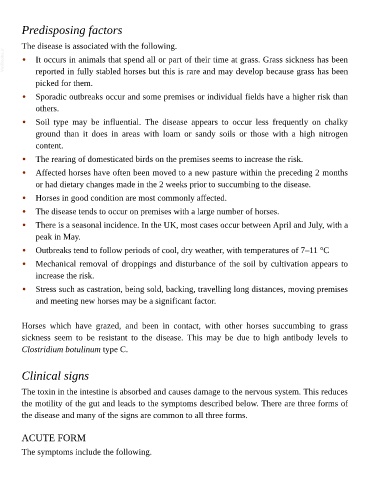Page 506 - The Veterinary Care of the Horse
P. 506
Predisposing factors
The disease is associated with the following.
VetBooks.ir • It occurs in animals that spend all or part of their time at grass. Grass sickness has been
reported in fully stabled horses but this is rare and may develop because grass has been
picked for them.
• Sporadic outbreaks occur and some premises or individual fields have a higher risk than
others.
• Soil type may be influential. The disease appears to occur less frequently on chalky
ground than it does in areas with loam or sandy soils or those with a high nitrogen
content.
• The rearing of domesticated birds on the premises seems to increase the risk.
• Affected horses have often been moved to a new pasture within the preceding 2 months
or had dietary changes made in the 2 weeks prior to succumbing to the disease.
• Horses in good condition are most commonly affected.
• The disease tends to occur on premises with a large number of horses.
• There is a seasonal incidence. In the UK, most cases occur between April and July, with a
peak in May.
• Outbreaks tend to follow periods of cool, dry weather, with temperatures of 7–11 °C
• Mechanical removal of droppings and disturbance of the soil by cultivation appears to
increase the risk.
• Stress such as castration, being sold, backing, travelling long distances, moving premises
and meeting new horses may be a significant factor.
Horses which have grazed, and been in contact, with other horses succumbing to grass
sickness seem to be resistant to the disease. This may be due to high antibody levels to
Clostridium botulinum type C.
Clinical signs
The toxin in the intestine is absorbed and causes damage to the nervous system. This reduces
the motility of the gut and leads to the symptoms described below. There are three forms of
the disease and many of the signs are common to all three forms.
ACUTE FORM
The symptoms include the following.

